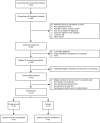Vaginal progesterone to prevent preterm delivery among HIV-infected pregnant women in Zambia: A feasibility study
- PMID: 31995557
- PMCID: PMC6988922
- DOI: 10.1371/journal.pone.0224874
Vaginal progesterone to prevent preterm delivery among HIV-infected pregnant women in Zambia: A feasibility study
Abstract
Antenatal vaginal progesterone (VP) reduces the risk of preterm birth (PTB) in women with shortened cervical length, and we hypothesize that it may also prevent PTB in women with HIV as their primary risk factor. We conducted a pilot feasibility study in Lusaka, Zambia to investigate uptake, adherence, and retention in preparation for a future efficacy trial. This was a double-masked, placebo-controlled, randomized trial of 200mg daily self-administered VP suppository or placebo. Pregnant women with HIV who were initiating or continuing antiretroviral therapy were eligible for participation. Potential participants underwent ultrasound to assess eligibility; we excluded those ≥24 gestational weeks, with non-viable, multiple gestation, or extrauterine pregnancies, with short cervix (<2.0cm), or with prior spontaneous PTB. Participants initiated study product between 20-24 weeks of gestation and continued to 37 weeks (or delivery, if sooner). The primary outcome was adherence (proportion achieving ≥80% study product use), assessed by dye stain assay of returned single-use vaginal applicators. Secondary outcomes with pre-defined feasibility targets were: uptake (≥50% eligible participants enrolled) and retention (≥90% ascertainment of delivery outcomes). We also evaluated preliminary efficacy by comparing the risk of spontaneous PTB <37 weeks between groups. From July 2017 to June 2018, 208 HIV-infected pregnant women were eligible for screening and 140 (uptake = 67%) were randomly allocated to VP (n = 70) or placebo (n = 70). Mean adherence was 94% (SD±9.4); 91% (n = 125/137) achieved overall adherence ≥80%. Delivery outcomes were ascertained from 134 (96%) participants. Spontaneous PTB occurred in 10 participants (15%) receiving placebo and 8 (12%) receiving progesterone (RR 0.82; 95%CI:0.34-1.97). Spontaneous PTB < 34 weeks occurred in 6 (9%) receiving placebo and 4 (6%) receiving progesterone (RR 0.67; 95%CI:0.20-2.67). In contrast to findings from vaginal microbicide studies in HIV-uninfected, non-pregnant women, our trial participants were highly adherent to daily self-administered vaginal progesterone. The study's a priori criteria for uptake, adherence, and retention were met, indicating that a phase III efficacy trial would be feasible.
Conflict of interest statement
The authors have declared that no competing interests exist.
Figures
Similar articles
-
Acceptability of a trial of vaginal progesterone for the prevention of preterm birth among HIV-infected women in Lusaka, Zambia: A mixed methods study.PLoS One. 2020 Sep 24;15(9):e0238748. doi: 10.1371/journal.pone.0238748. eCollection 2020. PLoS One. 2020. PMID: 32970697 Free PMC article.
-
Vaginal progesterone to reduce preterm birth among HIV-infected pregnant women in Zambia: a feasibility study protocol.Pilot Feasibility Stud. 2017 Jul 18;4:21. doi: 10.1186/s40814-017-0170-7. eCollection 2018. Pilot Feasibility Stud. 2017. PMID: 28729911 Free PMC article.
-
Vaginal progesterone reduces the rate of preterm birth in women with a sonographic short cervix: a multicenter, randomized, double-blind, placebo-controlled trial.Ultrasound Obstet Gynecol. 2011 Jul;38(1):18-31. doi: 10.1002/uog.9017. Epub 2011 Jun 15. Ultrasound Obstet Gynecol. 2011. PMID: 21472815 Free PMC article. Clinical Trial.
-
Vaginal Progesterone to Prevent Spontaneous Preterm Birth in Women With a Sonographic Short Cervix: The Story of the PREGNANT Trial.Clin Obstet Gynecol. 2024 Jun 1;67(2):433-457. doi: 10.1097/GRF.0000000000000867. Epub 2024 Apr 5. Clin Obstet Gynecol. 2024. PMID: 38576410 Free PMC article. Review.
-
Cervical stitch (cerclage) in combination with other treatments for preventing spontaneous preterm birth in singleton pregnancies.Cochrane Database Syst Rev. 2020 Sep 24;9(9):CD012871. doi: 10.1002/14651858.CD012871.pub2. Cochrane Database Syst Rev. 2020. PMID: 32970845 Free PMC article.
Cited by
-
Prediction and prevention of preterm birth in pregnant women living with HIV on antiretroviral therapy.Expert Rev Anti Infect Ther. 2022 Jun;20(6):837-848. doi: 10.1080/14787210.2022.2046463. Epub 2022 Mar 1. Expert Rev Anti Infect Ther. 2022. PMID: 35196941 Free PMC article. Review.
-
Weekly 17 alpha-hydroxyprogesterone caproate to prevent preterm birth among women living with HIV: a randomised, double-blind, placebo-controlled trial.Lancet HIV. 2021 Oct;8(10):e605-e613. doi: 10.1016/S2352-3018(21)00150-8. Epub 2021 Sep 9. Lancet HIV. 2021. PMID: 34509197 Free PMC article. Clinical Trial.
-
Acceptability of a trial of vaginal progesterone for the prevention of preterm birth among HIV-infected women in Lusaka, Zambia: A mixed methods study.PLoS One. 2020 Sep 24;15(9):e0238748. doi: 10.1371/journal.pone.0238748. eCollection 2020. PLoS One. 2020. PMID: 32970697 Free PMC article.
-
Perinatal outcomes in women living with HIV-1 and receiving antiretroviral therapy-a systematic review and meta-analysis.Acta Obstet Gynecol Scand. 2022 Feb;101(2):168-182. doi: 10.1111/aogs.14282. Epub 2021 Oct 27. Acta Obstet Gynecol Scand. 2022. PMID: 34704251 Free PMC article.
References
-
- March of Dimes P, Save the Children, WHO. Born too Soon: the Global Action Report on Preterm Birth. Geneva: WHO, 2012.
-
- Blencowe H, Cousens S, Oestergaard MZ, Chou D, Moller A-B, Narwal R, et al. National, regional, and worldwide estimates of preterm birth rates in the year 2010 with time trends since 1990 for selected countries: a systematic analysis and implications. The Lancet. 2012;379(9832):2162–72. 10.1016/s0140-6736(12)60820-4 - DOI - PubMed
-
- da Fonseca EB, Bittar RE, Carvalho MH, Zugaib M. Prophylactic administration of progesterone by vaginal suppository to reduce the incidence of spontaneous preterm birth in women at increased risk: a randomized placebo-controlled double-blind study. Am J Obstet Gynecol. 2003;188(2):419–24. 10.1067/mob.2003.41 . - DOI - PubMed
Publication types
MeSH terms
Substances
Grants and funding
LinkOut - more resources
Full Text Sources
Medical
Miscellaneous



